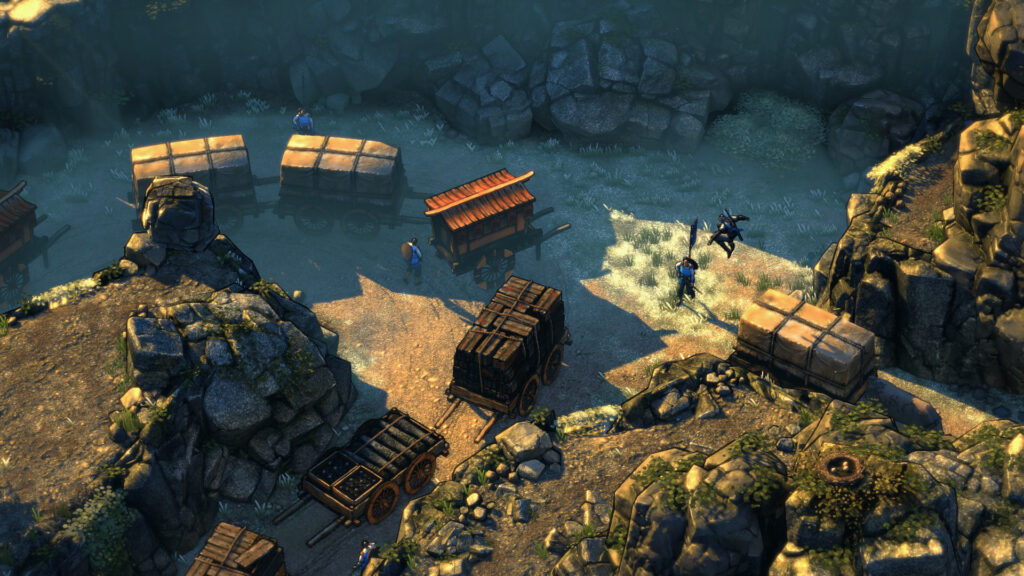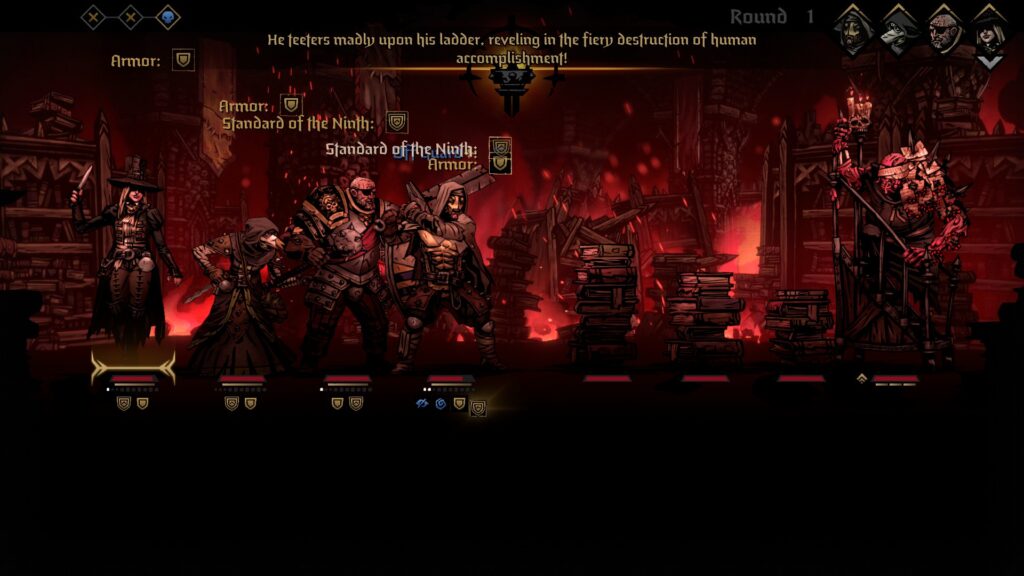2023 was a year of studio shuttering and closures, with Mimimi Games sadly on the list. The studio redefined tactical stealth design with Shadow Tactics. And yet, despite how well the series is, they struggled trying to make this a long-term commercial success.
As I think about the strategy genre, and the complexity of them, I wonder if it’s time for a structural change to how strategy and tactics games are made.
Numbers, Cones, and Dice Rolls
The strategy/tactical genre are some of the meatiest games on the market — they often provide dozens of hours of choices, playstyles, examining maps, planning routes, and more on the low end of the scale. For the peaks of the genre, that playtime can become infinite with people creating new campaigns, downloading mods, and just the randomness that can occur. They are also some of the “ugliest” games to show people, and yes, I did use the word “ugly” to describe a game like Shadow Tactics.
When we talk about marketing games, there are two kinds of screenshots you should show — those that make the game exciting to look at, and those that let people know just what the heck the game is about. When you look at the former on any strategy/tactics store page, you see characters performing amazing shots, particle effects, enemies flung backward into explosions, and so on. And then you look at the “gameplay” screens, and what you get are a bunch of characters standing around, numbers floating all over the place, mathematical breakdowns of accuracy and to-hit chances, and for stealth ones: vision cones; lots and lots of vision cones.
On a stream while I was playing an SRPG one of my viewers said that his friend hates these games as they just look like “numbers, the game,” and that comment isn’t too off. No matter how beautiful or different the art style is, no matter how monstrous the enemies are, or how violent the game is, these games still revolve around checking numbers, vision radius, and rechecking the to-hit chance. Even the XCOM games by Firaxis with their action cameras still use the same general UI and GUI the genre has used for over 30 years now; it wasn’t until the expansion for XCOM 2 that they started implementing some of the QOL features modders have been adding.

Shadow Tactics was a breakout success, but sadly also represented the peak of that audience size (source steam)
The problem is that these GUI/UIs are like poison to new players. Some throw everything at the player and then they are like a deer looking at headlights wondering what is going on; others hide all the important information behind tooltips and layers of windows and then the person becomes lost. Then there are the ones that feel cumbersome to use even if you know how they work. As I’ve said before, I cannot stand the traditional UI/UX of roguelikes anymore with how slow it is to move and turn characters around.
There are two examples of strategy/RPGs that have gone out of their way to make their games present better, with one being Darkest Dungeon 2. Besides the complete rebuild of the game’s style into a 2-and-a-half D look, the entire GUI and systems were redesigned to focus less on looking at numbers and paying attention to the tokens and dynamics of skills. You still have challenging gameplay, but it presents itself far better and clearer than other examples of the genre, including the first Darkest Dungeon.
Tactica Time
2023 also saw the release of Persona Tactica — a tactical RPG based off Persona 5. The game drew inspiration not from XCOM, but from Mario + Rabbids. The UI/GUI was built to work with a gamepad more so than a keyboard and mouse, and yet, it still provided a very clean and approachable game. Does Persona Tactica have the same depth as XCOM? No way. What it does do is provide much of the same gameplay and loops minus needing to review multiple windows of details, clicking slowly on the map and watching characters go into position. You could do 4 or 5 maps in Persona Tactica in the time it would take you to complete one standard map in XCOM 2. If I never have to manually move 4 or more characters slowly across a field one turn at a time ever again, it would be too soon.
However, what you’re doing on those maps is far simpler than anything in XCOM 2. And therein lies the problem when discussing the evolution of strategy design.
Old vs. New
The strategy genre has had the fewest reinventions and evolutions of design out of any other genre on the market. Part of this is that the fanbase has been around for a long time — people who enjoyed the original X-COM still want to play games like that, or mods for it. Paradox Interactive’s entire audience and fanbase are all the people who enjoyed and figured out games like Crusader Kings, Europa Universalis and so on. These games do well, but they have also become as infamous as the fighting genre as being impenetrable to play if you didn’t grow up with them. The biggest division for strategy design was when the MOBA genre blew up thanks to League of Legends.
There is a market for stealth games, tactical games, and the like, but it has become an echo chamber. Any time that one of these franchises tries to shift their design in a different direction or change the UI in some way, fans will immediately say that the developers are “selling out” or “dumbing down.” And what that means is that for series like Shadow Tactics that did amazingly well, trying to follow that up with bigger and better games becomes a lot harder. Making a more advanced strategy or stealth game is not going to bring in or create more fans — there is a finite pool of consumers who will want to play something that technical and challenging. There is a thought that strategy design is inherently a niche genre; especially when compared to shooters, platformers, and action games.

no one expected the Mario X Rabbids games to be good, but they won people over for bringing fresh ideas to turn-based strategy (source: Game Informer)
But then I think about horror, and whether you love or hate the horror scene today, it did have a reinvention in the indie space. Some people make horror games as close to the old school as possible, those that just do something completely out of left field, and everything in the middle. It is admittedly very rare to see that variety out of strategy/tactical ones. For the ones that do present themselves with a different structure or different rules for their tactical layer, they still often fall back to the same presentations and UI of games that came before. For me personally, after playing Persona Tactica and Mario+ Rabbids, I do think strategy RPGs and tactical games should be redesigned to be playable with their depth using a gamepad interface.
Marketing is still such a factor and the one area that strategy games will always suffer in. Midnight Sons by Firaxis was an amazing and original take on combining tactical play with deck building; it also was hurt by people thinking that it was either going to be some “numbers game” or just another “Marvel game.” And this presents a question that no one has figured out the answer to: How do you present the depth of a strategy game that still makes it appealing to newcomers and the larger market? And likewise, if you decide to make a strategy game that is explicitly easier to play than anything else, how do you market that to new people?

Darkest Dungeon 2 did a lot to improve the GUI and experience of managing combat (source author)
What I want to see is a game that has all the depth and mechanics of XCOM or Phoenix Point, but with the presentation and approachability of a game designed for audiences in the past 5 years. And before anyone types a comment below, yes, I know this is going to be difficult to do. Strategy and tactical design are some of the most interesting games to play, but the genre itself, much like adventure games for a time, only focus on the same UI/UX that worked 20+ years ago. But again, genres have had to adapt and change with the times; allowing designers to create new and original takes that would have never been conceived when they first appeared.
Where Can Strategy Go?
As I’m writing my next book on RTS design, I’ve been thinking a lot about the modern strategy market and how it has become a closed feedback loop of fans and designers trying to chase the highs of the past, and then many games wondering why they’re not able to sustain themselves. Something has to give — either these games need to be built with small dev cycles and costs and the days of expecting a StarCraft level of success are gone, or they need to look outside of the same audience of people who have played every Paradox game, XCOM, Total War, etc., who just want to focus on the extreme ends of macro or micro play.
For the strategy fans in the audience: what do you think about the genre? Can it have a reinvention, should it have a reinvention, and if so, how?
If you would like to support what I do and let me do more daily streaming, be sure to check out my patreon.
My discord is now open to everyone for chatting about games and game design.

